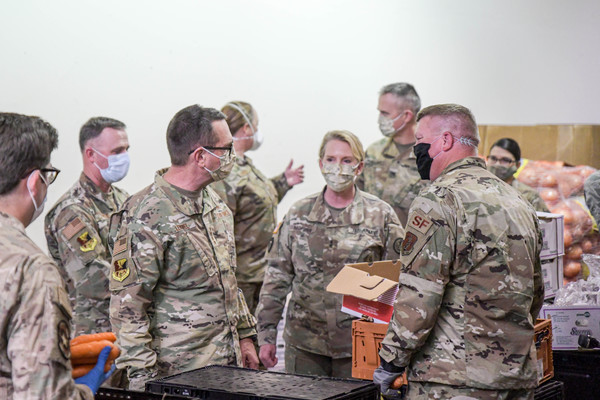Story by Robert Seyller, Texas Military Department Public Affairs
After over a year of preparation, the Texas Guard is officially launching the Texas Military Department Joint Innovation Unit: TMDx.
 Gen. Joseph L. Lengyel, chief of the National Guard Bureau, along with Maj. Gen. Tracy R. Norris, the adjutant general of Texas, visit Texas National Guard service members serving at the Tarrant Area Food Bank in Fort Worth, Texas, April 29, 2020.
Gen. Joseph L. Lengyel, chief of the National Guard Bureau, along with Maj. Gen. Tracy R. Norris, the adjutant general of Texas, visit Texas National Guard service members serving at the Tarrant Area Food Bank in Fort Worth, Texas, April 29, 2020.
The original plan called for a live event at the Capital Factory in Austin, home to the TMDx flagship innovation hub. However, recent concerns over COVID-19 forced the program to do exactly what it was designed for – partner, innovate and come up with a solution. That partnership came in the form of a livestreamed event, hosted by Capital Factory and simulcast across multiple social media platforms, July 15.
The launch, hosted by Sean Duffy, VP of partnerships at Capital Factory, featured appearances by Gen. Joseph Lengyel, chief of the National Guard Bureau; Maj. Gen. Tracy R. Norris, the adjutant general of Texas; and Maj. Alex Goldberg, TMDx managing director.
TMDx will utilize the Texas Guard’s position as the largest state military force in the country to leverage partnerships in industry and academia throughout the Texas innovation corridor to develop a new framework for military problem-solving.
Pilot Training Next, a technology-focused pilot preparation course founded in Austin, along with partnerships in construction, software programs and 3D printing technology, was just one of the TMDx noted successes highlighted during the event.
Lengyel focused on the 3D printing program during his remarks as he noted that Texas had won the National Guard Bureau’s national innovation competition. The program will allow F-16 maintainers to print replacement parts for the F-16 fighter aircraft, shortening logistical delays for parts and reducing costs.
“No one innovates like the National Guard and especially not like Texans,” said Lengyel. “This same technology was also able to print personal protective equipment and ventilator parts that we can use during our COVID-19 response.”
Speed and the ability to respond quickly to growing threats is imperative.
“It all comes down to needing to move faster,” said Goldberg. “Our adversaries are moving faster – faster in space, faster in hypersonic and faster in fielding commercial technology.”
The growing presence of near-peer threats are considered to be outpacing the U.S. in innovation.
“The status quo is comfortable, but what works today to ensure our national security will not be good enough for the challenges on the horizon,” said Norris. “The military moves slower than we would like and are moving away from a ‘no because’ mindset to a mindset of, ‘How do we get to yes?’”
The program’s launch in Austin will be a first step, according to Goldberg, who shared plans for expansion to San Antonio, Houston, Dallas, Ft. Worth and El Paso.